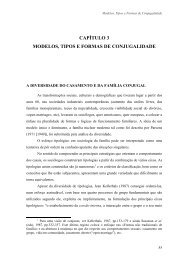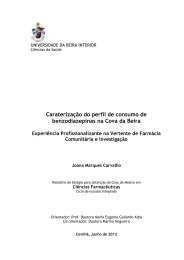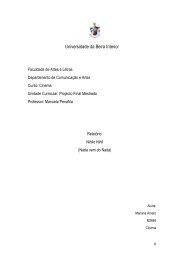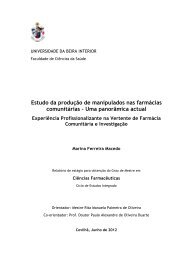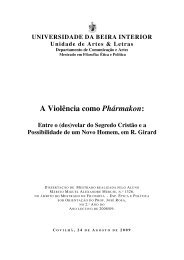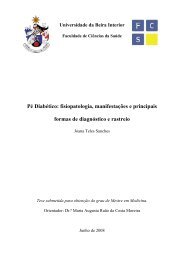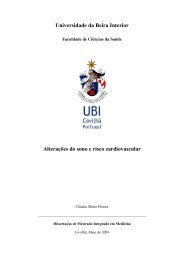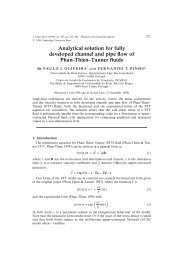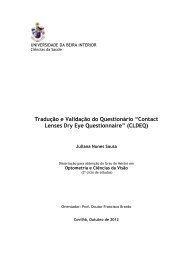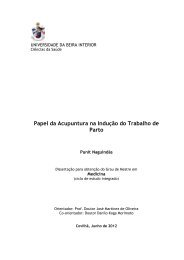Tese_Tânia Vieira.pdf - Ubi Thesis
Tese_Tânia Vieira.pdf - Ubi Thesis
Tese_Tânia Vieira.pdf - Ubi Thesis
Create successful ePaper yourself
Turn your PDF publications into a flip-book with our unique Google optimized e-Paper software.
Chapter III – Results and Discussion<br />
The combination of the two types of nanoparticles (AgNPs and chitosan/dextran<br />
nanoparticles) herein produced provided results for MIC as lower as 1.5 µg/mL with AgNPs<br />
produced by NaBH 4 reduction, and 3.0 µg/mL with AgNPs produced by C 6 H 8 O 6 reduction. Still,<br />
AgNPs produced into chitosan/dextran nanoparticles with NaBH 4 or with C 6 H 8 O 6 presented a<br />
higher MIC value, 23.50 µg/mL and 11.75 µg/mL respectively, compared to those produced by<br />
the combination of both types of nanoparticles. The AgNPs produced into chitosan/dextran<br />
nanoparticles were too big, which can be a disadvantage in terms of the antibacterial activity, as<br />
already reported for AgNPs. The combination of both nanoparticles presented a better<br />
antibacterial activity than AgNPs alone. Therefore, such combination was an advantage to<br />
improve the antibacterial activity of AgNPs.<br />
MBC values also determined in this work were in all cases, except for the chitosan/dextran<br />
nanoparticles with AgNPs (C 6 H 8 O 6 ), above of those obtained for MIC. Thereby, a higher<br />
concentration of AgNO 3 was needed to kill the bacteria. In this study, chitosan was not able to<br />
eradicate the bacteria. However, it was able to inhibit bacteria growth as observed through MIC<br />
assay. Hereupon, the ability to completely kill bacteria is due to the bactericidal effect of<br />
AgNO 3 .<br />
As mentioned in chapter I, the mechanism by which the AgNPs are able to interact with<br />
the bacteria is not fully understood (Kim et al. 2007; Raffi et al. 2008; Guzmán et al. 2009;<br />
Potara et al. 2011). However, there are some reports that showed that the AgNPs may attach on<br />
the surface of the cell membrane and disturb its power function, such as permeability and<br />
electron transport chain (Kim et al. 2007; Guzmán et al. 2009). AgNPs can also penetrated inside<br />
the bacteria and caused damage by interacting with phosphate and sulfur containing compounds,<br />
such as DNA (Raffi et al. 2008). Finally, the production of ROS by the AgNPs is also responsible<br />
for their antimicrobial mechanism (Kim et al. 2007; Potara et al. 2011). Even though the<br />
antibacterial mechanism of AgNPs is not totally understood, the antimicrobial effect of Ag + has<br />
been quite well known and it is routinely used in the pharmaceutical industry for wound healing<br />
and similar anti-infection-related applications (Parashar et al. 2011). These new AgNPs with<br />
chitosan/dextran nanoparticles showed to have biocidal effect and potential to reduce bacterial<br />
growth for practical applications.<br />
3.5. Evaluation of the cytotoxic profile of the produced<br />
nanoparticles<br />
Nowadays orthopedic surgery is extremely important and several biomaterials are used for<br />
bone regeneration (Campoccia et al. 2010). The coating of orthopaedic implants with AgNPs is an<br />
interesting strategy to decrease the postoperative infection rates (Albers et al. 2011). However,<br />
silver induced cytotoxicity to bone cells has not been investigated in detail (Albers et al. 2011).<br />
Therefore, in this study the cytotoxic profile of the different types of nanoparticles, herein<br />
42




